Abstract
ras proto-oncogenes with a cyclobutane-type thymine photodimer (cis-syn or trans-syn isomer) were constructed by replacement of a portion of the gene with a chemically synthesized fragment. When the genes were transfected by the calcium phosphate method into mouse NIH3T3 cells, they induced focus-formation, indicating that both photoproducts were mutagenic in mammalian cells. Sequence analysis of the ras gene fragments derived from the transformed cells showed that the genes were activated by a point mutation. The mutations detected most frequently were 3'-T-->A for the cis-syn isomer and 5'-T-->A for the trans-syn isomer. In contrast, a different trend of mutations was observed when a primer on a DNA template with a cis-syn dimer was extended in vitro by either DNA polymerase beta or alpha.
Full text
PDF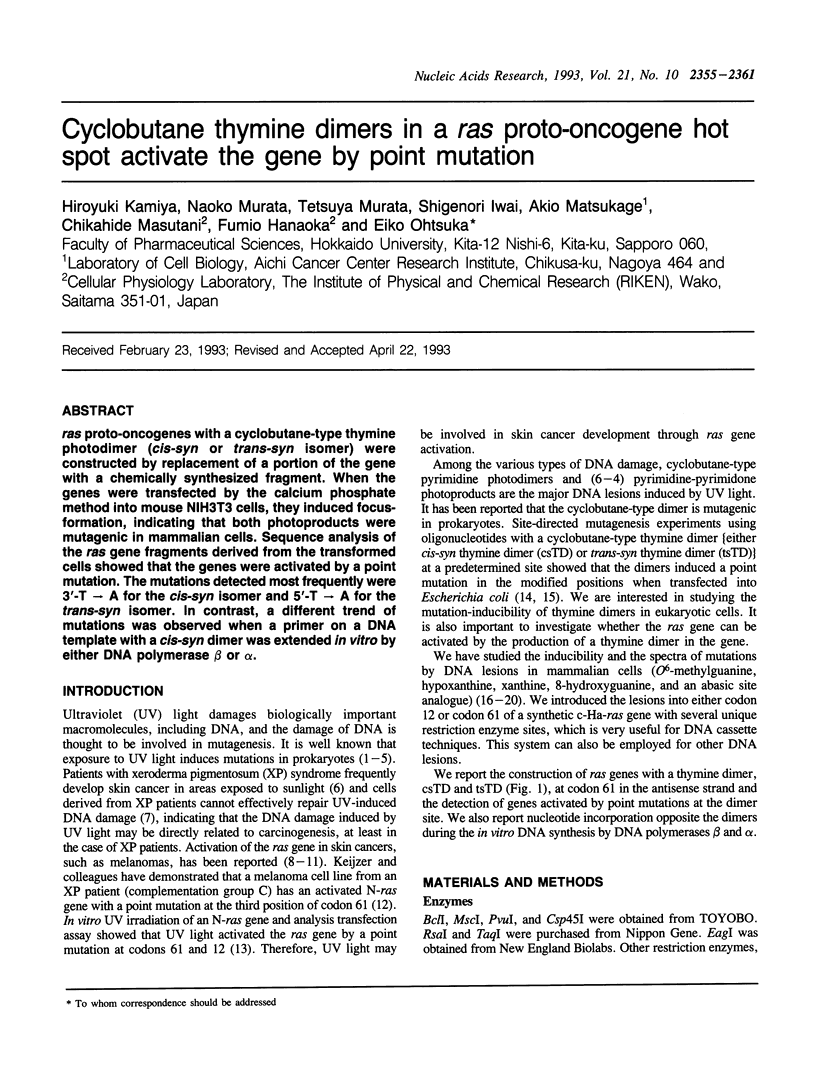
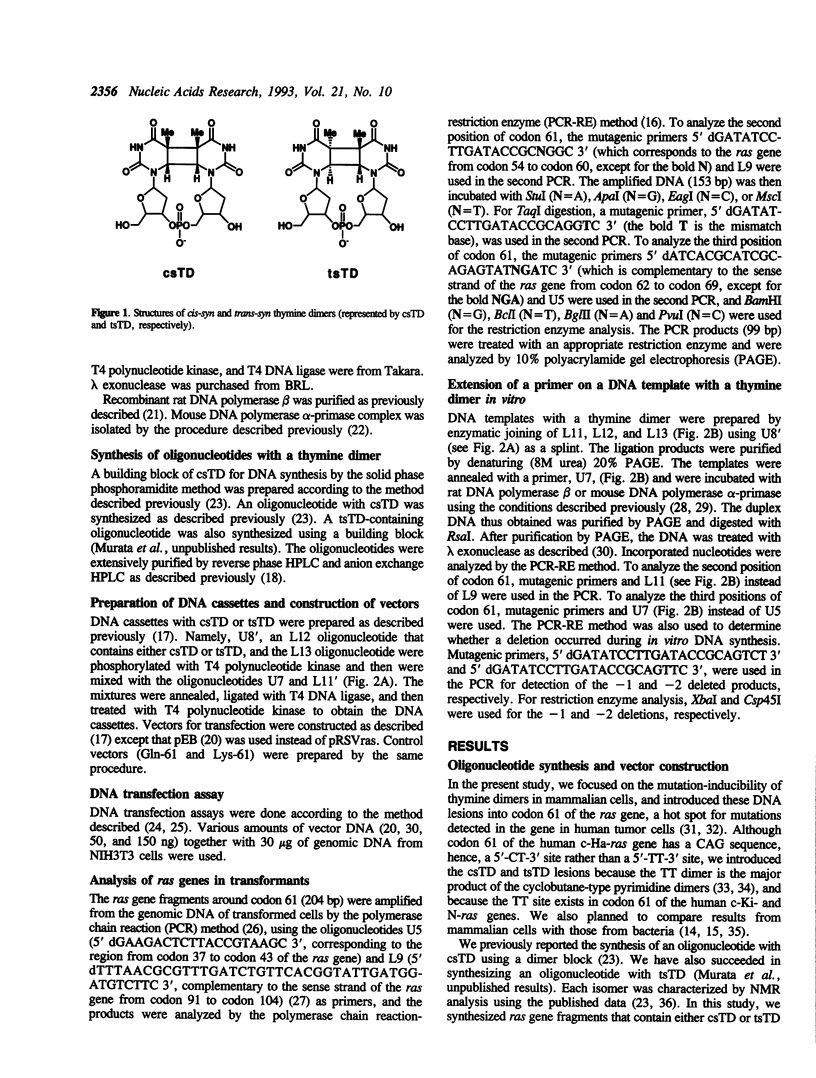

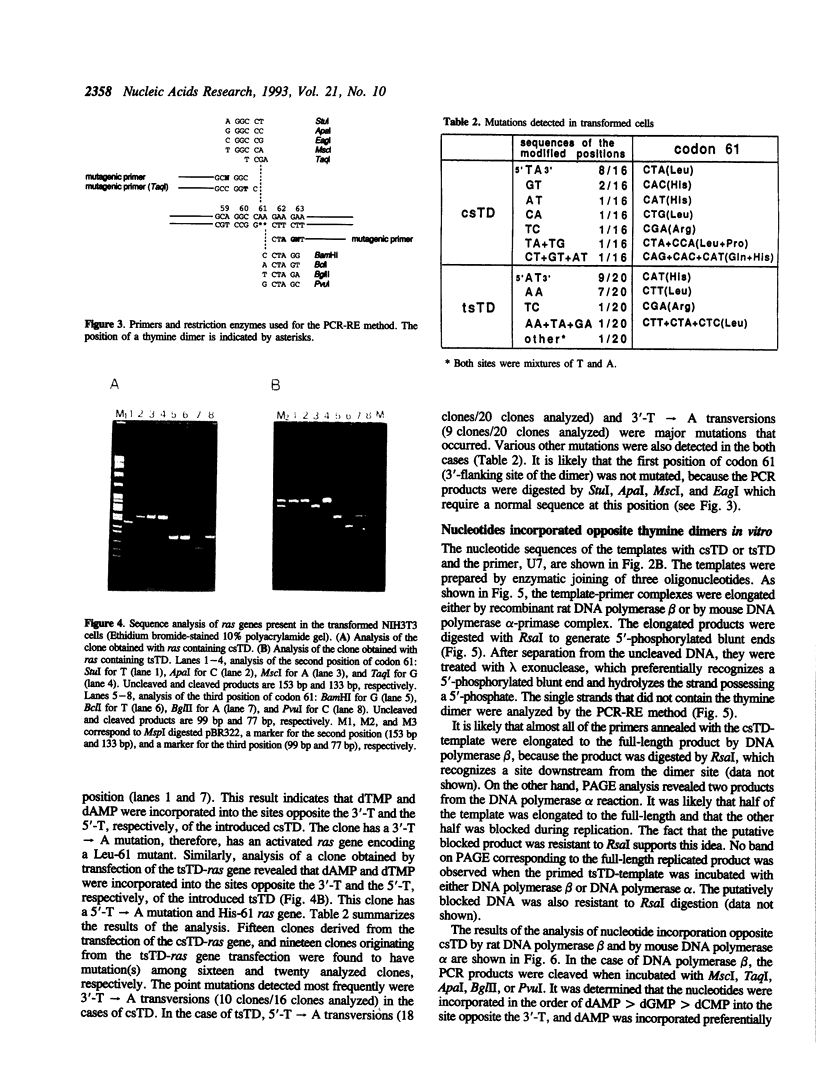

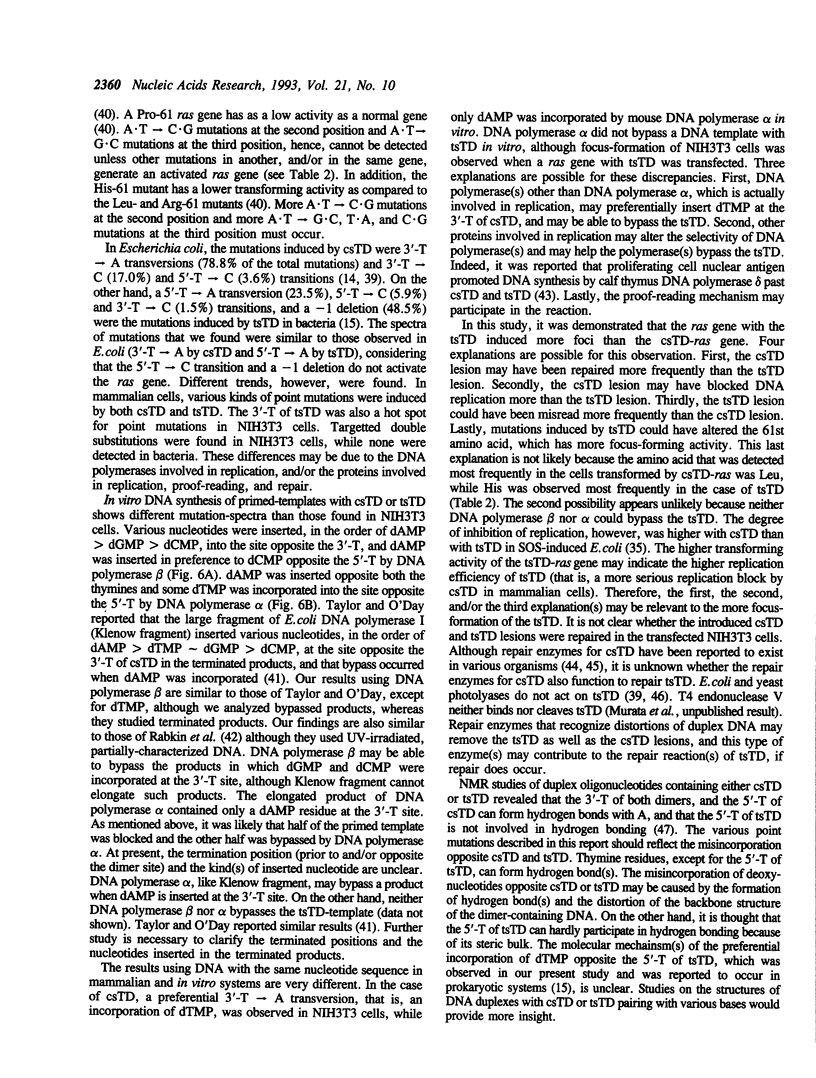
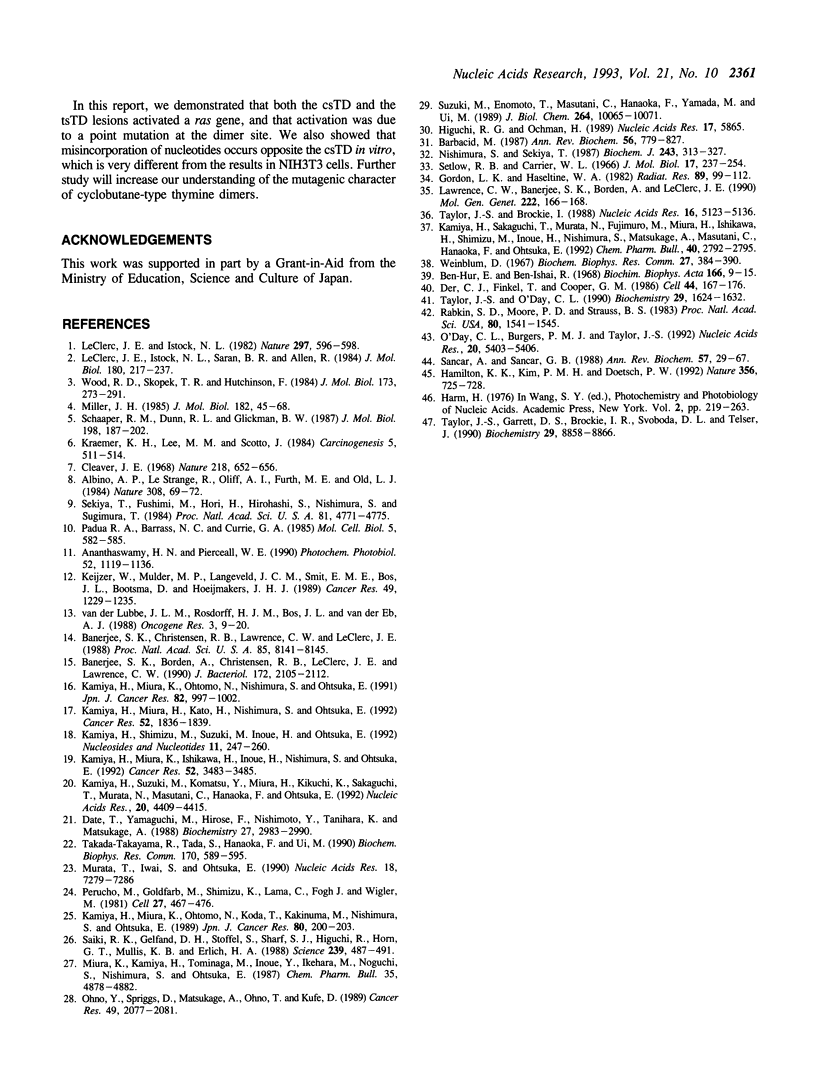
Images in this article
Selected References
These references are in PubMed. This may not be the complete list of references from this article.
- Albino A. P., Le Strange R., Oliff A. I., Furth M. E., Old L. J. Transforming ras genes from human melanoma: a manifestation of tumour heterogeneity? Nature. 1984 Mar 1;308(5954):69–72. doi: 10.1038/308069a0. [DOI] [PubMed] [Google Scholar]
- Ananthaswamy H. N., Pierceall W. E. Molecular mechanisms of ultraviolet radiation carcinogenesis. Photochem Photobiol. 1990 Dec;52(6):1119–1136. doi: 10.1111/j.1751-1097.1990.tb08452.x. [DOI] [PubMed] [Google Scholar]
- Banerjee S. K., Borden A., Christensen R. B., LeClerc J. E., Lawrence C. W. SOS-dependent replication past a single trans-syn T-T cyclobutane dimer gives a different mutation spectrum and increased error rate compared with replication past this lesion in uninduced cells. J Bacteriol. 1990 Apr;172(4):2105–2112. doi: 10.1128/jb.172.4.2105-2112.1990. [DOI] [PMC free article] [PubMed] [Google Scholar]
- Banerjee S. K., Christensen R. B., Lawrence C. W., LeClerc J. E. Frequency and spectrum of mutations produced by a single cis-syn thymine-thymine cyclobutane dimer in a single-stranded vector. Proc Natl Acad Sci U S A. 1988 Nov;85(21):8141–8145. doi: 10.1073/pnas.85.21.8141. [DOI] [PMC free article] [PubMed] [Google Scholar]
- Barbacid M. ras genes. Annu Rev Biochem. 1987;56:779–827. doi: 10.1146/annurev.bi.56.070187.004023. [DOI] [PubMed] [Google Scholar]
- Ben-Hur E., Ben-Ishai R. Trans-syn thymine dimers in ultraviolet-irradiated denatured DNA: identification and photoreactivability. Biochim Biophys Acta. 1968 Aug 23;166(1):9–15. doi: 10.1016/0005-2787(68)90485-1. [DOI] [PubMed] [Google Scholar]
- Cleaver J. E. Defective repair replication of DNA in xeroderma pigmentosum. Nature. 1968 May 18;218(5142):652–656. doi: 10.1038/218652a0. [DOI] [PubMed] [Google Scholar]
- Date T., Yamaguchi M., Hirose F., Nishimoto Y., Tanihara K., Matsukage A. Expression of active rat DNA polymerase beta in Escherichia coli. Biochemistry. 1988 Apr 19;27(8):2983–2990. doi: 10.1021/bi00408a048. [DOI] [PubMed] [Google Scholar]
- Der C. J., Finkel T., Cooper G. M. Biological and biochemical properties of human rasH genes mutated at codon 61. Cell. 1986 Jan 17;44(1):167–176. doi: 10.1016/0092-8674(86)90495-2. [DOI] [PubMed] [Google Scholar]
- Gordon L. K., Haseltine W. A. Quantitation of cyclobutane pyrimidine dimer formation in double- and single-stranded DNA fragments of defined sequence. Radiat Res. 1982 Jan;89(1):99–112. [PubMed] [Google Scholar]
- Hamilton K. K., Kim P. M., Doetsch P. W. A eukaryotic DNA glycosylase/lyase recognizing ultraviolet light-induced pyrimidine dimers. Nature. 1992 Apr 23;356(6371):725–728. doi: 10.1038/356725a0. [DOI] [PubMed] [Google Scholar]
- Higuchi R. G., Ochman H. Production of single-stranded DNA templates by exonuclease digestion following the polymerase chain reaction. Nucleic Acids Res. 1989 Jul 25;17(14):5865–5865. doi: 10.1093/nar/17.14.5865. [DOI] [PMC free article] [PubMed] [Google Scholar]
- Kamiya H., Miura H., Kato H., Nishimura S., Ohtsuka E. Induction of mutation of a synthetic c-Ha-ras gene containing hypoxanthine. Cancer Res. 1992 Apr 1;52(7):1836–1839. [PubMed] [Google Scholar]
- Kamiya H., Miura K., Ishikawa H., Inoue H., Nishimura S., Ohtsuka E. c-Ha-ras containing 8-hydroxyguanine at codon 12 induces point mutations at the modified and adjacent positions. Cancer Res. 1992 Jun 15;52(12):3483–3485. [PubMed] [Google Scholar]
- Kamiya H., Miura K., Ohtomo N., Koda T., Kakinuma M., Nishimura S., Ohtsuka E. Transformation of NIH3T3 cells with synthetic c-Ha-ras genes. Jpn J Cancer Res. 1989 Mar;80(3):200–203. doi: 10.1111/j.1349-7006.1989.tb02291.x. [DOI] [PMC free article] [PubMed] [Google Scholar]
- Kamiya H., Miura K., Ohtomo N., Nishimura S., Ohtsuka E. Transforming activity of a synthetic c-Ha-ras gene containing O6-methylguanine in codon 12. Jpn J Cancer Res. 1991 Sep;82(9):997–1002. doi: 10.1111/j.1349-7006.1991.tb01934.x. [DOI] [PMC free article] [PubMed] [Google Scholar]
- Kamiya H., Sakaguchi T., Murata N., Fujimuro M., Miura H., Ishikawa H., Shimizu M., Inoue H., Nishimura S., Matsukage A. In vitro replication study of modified bases in ras sequences. Chem Pharm Bull (Tokyo) 1992 Oct;40(10):2792–2795. doi: 10.1248/cpb.40.2792. [DOI] [PubMed] [Google Scholar]
- Kamiya H., Suzuki M., Komatsu Y., Miura H., Kikuchi K., Sakaguchi T., Murata N., Masutani C., Hanaoka F., Ohtsuka E. An abasic site analogue activates a c-Ha-ras gene by a point mutation at modified and adjacent positions. Nucleic Acids Res. 1992 Sep 11;20(17):4409–4415. doi: 10.1093/nar/20.17.4409. [DOI] [PMC free article] [PubMed] [Google Scholar]
- Keijzer W., Mulder M. P., Langeveld J. C., Smit E. M., Bos J. L., Bootsma D., Hoeijmakers J. H. Establishment and characterization of a melanoma cell line from a xeroderma pigmentosum patient: activation of N-ras at a potential pyrimidine dimer site. Cancer Res. 1989 Mar 1;49(5):1229–1235. [PubMed] [Google Scholar]
- Kraemer K. H., Lee M. M., Scotto J. DNA repair protects against cutaneous and internal neoplasia: evidence from xeroderma pigmentosum. Carcinogenesis. 1984 Apr;5(4):511–514. doi: 10.1093/carcin/5.4.511. [DOI] [PubMed] [Google Scholar]
- Lawrence C. W., Banerjee S. K., Borden A., LeClerc J. E. T-T cyclobutane dimers are misinstructive, rather than non-instructive, mutagenic lesions. Mol Gen Genet. 1990 Jun;222(1):166–168. doi: 10.1007/BF00283040. [DOI] [PubMed] [Google Scholar]
- LeClerc J. E., Istock N. L., Saran B. R., Allen R., Jr Sequence analysis of ultraviolet-induced mutations in M13lacZ hybrid phage DNA. J Mol Biol. 1984 Dec 5;180(2):217–237. doi: 10.1016/s0022-2836(84)80001-7. [DOI] [PubMed] [Google Scholar]
- LeClerc J. E., Istock N. L. Specificity of UV mutagenesis in the lac promoter of M13lac hybrid phage DNA. Nature. 1982 Jun 17;297(5867):596–598. doi: 10.1038/297596a0. [DOI] [PubMed] [Google Scholar]
- Miller J. H. Mutagenic specificity of ultraviolet light. J Mol Biol. 1985 Mar 5;182(1):45–65. doi: 10.1016/0022-2836(85)90026-9. [DOI] [PubMed] [Google Scholar]
- Miura K., Kamiya H., Tominaga M., Inoue Y., Ikehara M., Noguchi S., Nishimura S., Ohtsuka E. Overproduction of cellular and activated Ha-ras proteins by mutating a synthetic gene. Chem Pharm Bull (Tokyo) 1987 Dec;35(12):4878–4882. doi: 10.1248/cpb.35.4878. [DOI] [PubMed] [Google Scholar]
- Murata T., Iwai S., Ohtsuka E. Synthesis and characterization of a substrate for T4 endonuclease V containing a phosphorodithioate linkage at the thymine dimer site. Nucleic Acids Res. 1990 Dec 25;18(24):7279–7286. doi: 10.1093/nar/18.24.7279. [DOI] [PMC free article] [PubMed] [Google Scholar]
- Nishimura S., Sekiya T. Human cancer and cellular oncogenes. Biochem J. 1987 Apr 15;243(2):313–327. doi: 10.1042/bj2430313. [DOI] [PMC free article] [PubMed] [Google Scholar]
- O'Day C. L., Burgers P. M., Taylor J. S. PCNA-induced DNA synthesis past cis-syn and trans-syn-I thymine dimers by calf thymus DNA polymerase delta in vitro. Nucleic Acids Res. 1992 Oct 25;20(20):5403–5406. doi: 10.1093/nar/20.20.5403. [DOI] [PMC free article] [PubMed] [Google Scholar]
- Ohno Y., Spriggs D., Matsukage A., Ohno T., Kufe D. Sequence-specific inhibition of DNA strand elongation by incorporation of 9-beta-D-arabinofuranosyladenine. Cancer Res. 1989 Apr 15;49(8):2077–2081. [PubMed] [Google Scholar]
- Padua R. A., Barrass N. C., Currie G. A. Activation of N-ras in a human melanoma cell line. Mol Cell Biol. 1985 Mar;5(3):582–585. doi: 10.1128/mcb.5.3.582. [DOI] [PMC free article] [PubMed] [Google Scholar]
- Perucho M., Goldfarb M., Shimizu K., Lama C., Fogh J., Wigler M. Human-tumor-derived cell lines contain common and different transforming genes. Cell. 1981 Dec;27(3 Pt 2):467–476. doi: 10.1016/0092-8674(81)90388-3. [DOI] [PubMed] [Google Scholar]
- Rabkin S. D., Moore P. D., Strauss B. S. In vitro bypass of UV-induced lesions by Escherichia coli DNA polymerase I: specificity of nucleotide incorporation. Proc Natl Acad Sci U S A. 1983 Mar;80(6):1541–1545. doi: 10.1073/pnas.80.6.1541. [DOI] [PMC free article] [PubMed] [Google Scholar]
- Saiki R. K., Gelfand D. H., Stoffel S., Scharf S. J., Higuchi R., Horn G. T., Mullis K. B., Erlich H. A. Primer-directed enzymatic amplification of DNA with a thermostable DNA polymerase. Science. 1988 Jan 29;239(4839):487–491. doi: 10.1126/science.2448875. [DOI] [PubMed] [Google Scholar]
- Sancar A., Sancar G. B. DNA repair enzymes. Annu Rev Biochem. 1988;57:29–67. doi: 10.1146/annurev.bi.57.070188.000333. [DOI] [PubMed] [Google Scholar]
- Schaaper R. M., Dunn R. L., Glickman B. W. Mechanisms of ultraviolet-induced mutation. Mutational spectra in the Escherichia coli lacI gene for a wild-type and an excision-repair-deficient strain. J Mol Biol. 1987 Nov 20;198(2):187–202. doi: 10.1016/0022-2836(87)90305-6. [DOI] [PubMed] [Google Scholar]
- Sekiya T., Fushimi M., Hori H., Hirohashi S., Nishimura S., Sugimura T. Molecular cloning and the total nucleotide sequence of the human c-Ha-ras-1 gene activated in a melanoma from a Japanese patient. Proc Natl Acad Sci U S A. 1984 Aug;81(15):4771–4775. doi: 10.1073/pnas.81.15.4771. [DOI] [PMC free article] [PubMed] [Google Scholar]
- Setlow R. B., Carrier W. L. Pyrimidine dimers in ultraviolet-irradiated DNA's. J Mol Biol. 1966 May;17(1):237–254. doi: 10.1016/s0022-2836(66)80105-5. [DOI] [PubMed] [Google Scholar]
- Suzuki M., Enomoto T., Masutani C., Hanaoka F., Yamada M., Ui M. DNA primase-DNA polymerase alpha assembly from mouse FM3A cells. Purification of constituting enzymes, reconstitution, and analysis of RNA priming as coupled to DNA synthesis. J Biol Chem. 1989 Jun 15;264(17):10065–10071. [PubMed] [Google Scholar]
- Takada-Takayama R., Tada S., Hanaoka F., Ui M. Peptide mapping of the four subunits of the mouse DNA polymerase alpha-primase complex. Biochem Biophys Res Commun. 1990 Jul 31;170(2):589–595. doi: 10.1016/0006-291x(90)92132-j. [DOI] [PubMed] [Google Scholar]
- Taylor J. S., Brockie I. R. Synthesis of a trans-syn thymine dimer building block. Solid phase synthesis of CGTAT[t,s]TATGC. Nucleic Acids Res. 1988 Jun 10;16(11):5123–5136. doi: 10.1093/nar/16.11.5123. [DOI] [PMC free article] [PubMed] [Google Scholar]
- Taylor J. S., Garrett D. S., Brockie I. R., Svoboda D. L., Telser J. 1H NMR assignment and melting temperature study of cis-syn and trans-syn thymine dimer containing duplexes of d(CGTATTATGC).d(GCATAATACG). Biochemistry. 1990 Sep 18;29(37):8858–8866. doi: 10.1021/bi00489a049. [DOI] [PubMed] [Google Scholar]
- Taylor J. S., O'Day C. L. cis-syn thymine dimers are not absolute blocks to replication by DNA polymerase I of Escherichia coli in vitro. Biochemistry. 1990 Feb 13;29(6):1624–1632. doi: 10.1021/bi00458a038. [DOI] [PubMed] [Google Scholar]
- Van der Lubbe J. L., Rosdorff H. J., Bos J. L., Van der Eb A. J. Activation of N-ras induced by ultraviolet irradiation in vitro. Oncogene Res. 1988;3(1):9–20. [PubMed] [Google Scholar]
- Weinblum D. Characterization of the photodimers from DNA. Biochem Biophys Res Commun. 1967 May 5;27(3):384–390. doi: 10.1016/s0006-291x(67)80111-6. [DOI] [PubMed] [Google Scholar]
- Wood R. D., Skopek T. R., Hutchinson F. Changes in DNA base sequence induced by targeted mutagenesis of lambda phage by ultraviolet light. J Mol Biol. 1984 Mar 5;173(3):273–291. doi: 10.1016/0022-2836(84)90121-9. [DOI] [PubMed] [Google Scholar]




